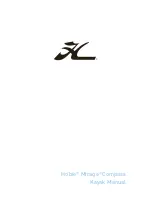
3-2
Section 3
Fuel System
C230
3.2 Fuel System
Fuel Valve
The fuel system on your Pursuit boat has
one fuel tank and is equipped with a manual
“ON/OFF” fuel valve. Refer to the Schemat-
ics section. The fuel valve and tank fitting
are accessed through deck plates under the
mechanical space hatch. The valve is off
when the handle is perpendicular to the fuel
flow.
The fuel delivery line is equipped with an
anti-siphon valve located where the line
attaches to the fuel tank. This valve helps
prevent gasoline from siphoning out of the
fuel tank should a line rupture.
All boats equipped with gasoline engines are
required to have anti-siphon valves by the
U.S. Coast Guard. DO NOT remove anti-
siphon valves from system. Anti-siphon
valves prevent fuel from flowing into bilge
should a fuel hose or fitting leak. If the valve
becomes clogged, clean and reinstall or
replace it.
Fuel Tanks
The fuel pick-up tubes are positioned in the
tanks to achieve optimum fuel usage, fuel
line routing, etc. At certain speeds and hull
trim angles, the fuel supply at the withdrawal
tube can increase or decrease accordingly.
Be extremely careful when attempting to
operate the boat when low on fuel. Though
some fuel may be in the tank, the trim angle
of the boat may cause the fuel to flow away
from the pickup tubes.
Fuel Gauge Senders
The fuel gauge senders are more accurate
when the boat is stationary and level.
Because of the change in attitude when the
boat is underway, variations in gauge read-
ings can occur. This system is a relative indi-
cation of the available fuel supply and not a
calibrated instrument.
Fuel Fills
A fuel fill is located on each gunwale and is
marked “GAS.” The fuel fill is opened by
turning it counterclockwise. After fueling,
screw the cap on in a clockwise direction
until an audible click is heard indicating that
the cap is seated. If the cap is lost or dam-
aged replace only with original equipment.
During refueling the tank vents out at both
the fuel fill plate and the vent located on the
side of the hull. Note: There should not be
any residual fuel at the vent but there could
be residual fuel at the deck fill plate. Do not
block or restrict either of these vents. Fill the
fuel tank slowly and monitor the fuel gauge
while filling. Once fueling is completed wash
the areas around the fuel fill(s) to help
reduce discoloration of the fiberglass or
striping. Use only the fuel recommended by
the outboard manufacturer; refer to the
engine owner’s manual for additional infor-
mation.
If fuel is added to any other tank, DO NOT
attempt to pump fuel out; these systems are
not designed to pump fuel. Fuel must be
removed by qualified personal only. Fuel in
other systems will also require replacement
of that system and/or many components.
EPA Fuel Fill
Содержание C 230
Страница 12: ...Operator Notes 8 C230...
Страница 22: ...Operator Notes 2 6 C230...
Страница 38: ...6 2 Operator Notes C230...
Страница 44: ...8 2 Operator Notes C230...
Страница 76: ...12 6 Operator Notes C230...
Страница 82: ...Operator Notes A 6 C230...
Страница 84: ...Appendix B Maintenance Log Date Hours Dealer Service Repairs B 2 C230 Maintenance Log...
Страница 85: ...Maintenance Log B 3 Appendix B C230 Date Hours Dealer Service Repairs...
Страница 86: ...Appendix B Maintenance Log Date Hours Dealer Service Repairs B 4 C230...
Страница 87: ...Boating Accident Report C 1 Appendix C C230 Boating Accident Report...
Страница 88: ...C 2 Appendix C Boating Accident Report C230...
Страница 89: ...Float Plan D 1 Appendix D C230 Float Plan...
Страница 90: ...Operator Notes D 2 C230...
Страница 94: ...Operator Notes E 4 C230...
Страница 95: ...Schematics F 1 Appendix F C230 Schematics...
Страница 96: ...F 2 Appendix F Schematics C230 C 230...
Страница 97: ...Schematics F 3 Appendix F C230 C 230...
Страница 98: ...F 4 Appendix F Schematics C230 C 230...
Страница 99: ...Schematics F 5 Appendix F C230 C 230...
Страница 100: ...Operator Notes F 6 C230...
Страница 101: ......
Страница 102: ......
















































